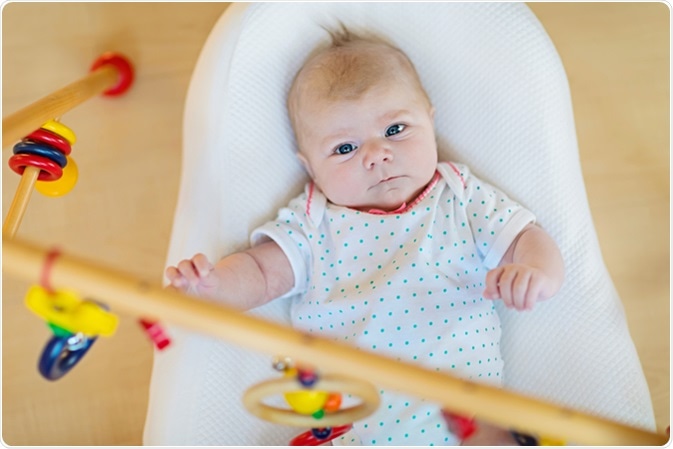Children require sensory stimulation of an appropriate nature and duration, at the right time. Failing to provide children with adequate sensory stimulation puts them at a high risk of developmental and cognitive delays. This is known to have been recorded in young babies who grew up in orphanages, as well as in preterm babies.

Image Credit: Romrodphoto / Shutterstock
One such sensory pathway is touch, which facilitates normal growth and development. From worms and rats to human beings, the offspring of each species show positive responses to supplemental touch.
Research is still ongoing into the best ways to stimulate touch and other sensations to promote growth normalization and an increase the level of response to multisensory stimuli, especially in children who were deprived of such stimulation in early life.
Multisensory integration is now recognized as being extremely important in the development of children. It seems to be acquired, matures with growth, and peaks in late childhood but with many variations depending on the level of prior experience.
Children with neurodevelopmental disorders often have impaired integration of multiple sensory modalities and must therefore be trained to perceive and to interpret them correctly.
Lack of tactile stimulation
Experiments on rat pups reared in isolation, under maternal care, and those reared in isolation but modified by brief sessions of stroking showed that deprivation of tactile stimulation, which took the form of licking by the mother rat, caused aberrations of behavior in the deprived pups even after they became adults.
Moreover, when these pups became mothers themselves, they failed to show fully maternal behavior towards their own pups. This has been seen in preterm babies kept in incubators for the first few weeks, as they are often deprived of touch but exposed to sounds and lights without always being able to correlate them with the source.
This can set the children back in responding to social as well as environmental cues as they grow up. On the other hand, “kangaroo care,” in which a baby is carried against the caregiver’s chest skin-to-skin in a carrier, wearing a diaper only, for at least an hour every day for a total duration of at least two weeks, has been shown to produce consistently improved scores in both mental and physical assessment, which persist for months afterward.

Image Credit: Kristina Bessolova / Shutterstock
Brain development and sensory stimulation
Mechanosensory stimulation is therefore very important in the development of a baby. In fact, it is difficult to reverse the negative effects in an individual who was deprived of such sensory stimulation in early life.
Research has shown that the newborn’s brain develops 2-3 million synapses each second. These synapses forge the route for sensory messages to reach the brain. The more synapses that are used, the more quickly these become permanent.
If not used, the synapses may die out and lead to a phenomenon known as pruning. Pruning ultimately prevents information overload by cutting out non-functional pathways.
Taken together, sensory stimulation is vital to develop sensory pathways in the brain and thus promote normal development. This stimulation also helps the child learn about the world, as well as communicate and form attachments to other people.
Normal maternal stimulation
In most cases, daily interactions between a mother and her infant cause stimulation of key senses, mostly touch, but also stimulation of the joints, hearing, vision, and balance.
According to research-based evidence, the daily activity found to be most stimulating is feeding, while playing with the baby, carrying, bathing, and changing the diaper/clothing are other sources of mechanosensory stimulation.

Image Credit: Evgeny Atamanenko / Shutterstock
Sucking on a pacifier or other object is also beneficial in terms of promoting growth and maturation in preterm babies. It is seen that such sucking activity influences gastrointestinal endocrine secretions via the vagus nerve and may thus increase insulin release, stimulate gastrointestinal motility, and functional maturation. The mother also benefits from this by activation of the gut endocrine system and improved energy intake.
When compared on a minute-by-minute basis, research indicates that the most exciting activity is playing with the baby. However, individual differences exist between mothers and infants, which affect the amount of stimulation that occurs with each activity. Thus, individual counseling should be given to ensure that each infant is optimally stimulated at home when planning a remedial program.
Order of sensory maturation
Another finding is that all sensory systems do not mature simultaneously, but rather in a specific order which does not vary.
This order includes tactile > vestibular > chemical > auditory > visual. The baby thus has five senses working at very different levels at the time of birth.
The fetus has already developed much experience of tactile and vestibular system sensations by the time of delivery, including feeling when the mother is walking, laughing, talking, exercising, bathing and so on. These different feelings are often accompanied by auditory cues and physiological differences such as an increased heartbeat, uterine contractions, and stroking feelings when toweling down.
The auditory system develops much later, however. Therefore, knowing how the baby receives various sensory modalities has much to do with how activities are planned.
Tips on sensory stimulation in babies
Some ways to promote stimulation of multiple senses in babies include:
- Introducing a variety of textured objects
- Playing in water at the appropriate temperature
- Holding the baby up to face level, or lying down where the baby can see the caregiver’s face
- Spending time outside the house in quiet listening
- Sucking on clean objects
- Playing music appropriate for the child
- Watching moving objects such as fan blades, leaves, branches or shadows on a wall
- Bouncing balls where the baby can see them bounce and come back up again
- Rattles and other colorful and movable toys or objects (should be light and without sharp edges)
- Foods of different tastes and textures
- Coloring, painting, stamping, and other art activities for toddlers
- Smelling various safe substances such as foods, flowers (if not allergic to pollen), and grass
- Looking through various transparent colored objects
The infant should be supervised during each of these activities. Furthermore, all objects should be clean and should not be capable of choking or suffocating the child.
References
Further Reading
Last Updated: Oct 28, 2022